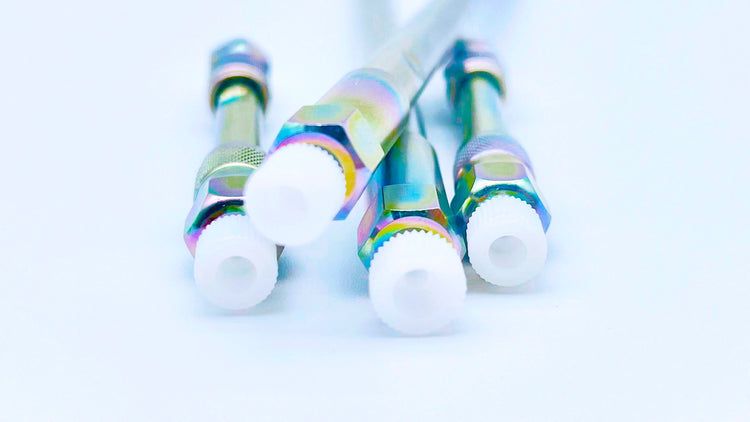
The two newly launched diamond-coated chromatography columns by Welch Materials, Inc. in 2023 are likely still fresh in the memories of many enthusiasts! They made a dazzling entrance into the chromatography field, renowned for their low adsorption, high sensitivity, and sharp chromatographic peak shapes.
For specific details, you can refer to:
New Product: Launches the Era of Diamond Like Carbon (DLC) Chromatography Columns

At the beginning of the new year in 2024,
Two formidable additions join the Welch Diamond DLC series:
Xtimate® DLC C18
Ultisil® DLC LP-C18
Their introduction provides you with increased selectivity, empowering your analysis of biomacromolecules (such as oligonucleotides, peptides, etc.) and small molecules prone to chelation with metals.
Xtimate® DLC C18 Chromatography Column
The filler production process and packing technology of Xtimate® DLC C18 chromatography column are consistent with the conventional stainless steel column Xtimate® C18: ultra-pure fully porous spherical silica gel (purity > 99.999%) is chosen as the matrix, and Welch’s patented organic-inorganic hybrid surface technology is employed to modify the silica gel matrix. The distinguishing feature lies in the use of high-performance surface-coated diamond thin film (HPS) technology for the column, which effectively reduces specific adsorption caused by metal interactions.
Advantages of Xtimate® C18 Chromatography Filler:
- Specifically designed for liquid chromatography methods, it can be used for method development across a wide pH range with diverse mobile phase systems and a broad temperature range.
- Demonstrates stable performance and an extended lifespan even under the most demanding conditions.
- Excellent peak shapes for the determination of basic compounds under neutral conditions, particularly showing outstanding tailing characteristics.
Simultaneously possessing typical characteristics of a diamond column:
- Inert column, effectively reducing specific adsorption.
- Improving peak shapes, enhancing separation efficiency.
- Smoother baseline, higher sensitivity.
- Substantially reducing sample residues, minimizing column activation and passivation time, thereby improving experimental efficiency.
Chromatography Column Specifications:
Bonded Phase: C18
Carbon Load: 14%
End-Capping: Double End-Capped
Pore Size: 120Å
Particle Size: 5μm
Surface Area: 320m²/g
pH Stability: 1.0-12.5
Maximum Pressure Tolerance: 40MPa
USP Classification: L1
Application Case
Oligonucleotide Detection Application
Chromatographic Conditions:
- Chromatography Columns:
- Xtimate® C18, 4.6×250mm, 5μm (conventional stainless steel column).
- Xtimate® DLC C18, 4.6×250mm, 5μm (diamond column).
- Instrument Model: Agilent 1260;
- Mobile Phases:
- A: Phosphate buffer/methanol=95/5;
- B: Phosphate buffer/methanol=75/25;
- Detection Wavelength: 260nm;
- Column Temperature: 25℃;
- Flow Rate: 1.0mL/min;
- Injection Volume: 10μL.
Overlap Spectrum Chart:

Conclusion:
Diamond column chromatography, when used to separate oligonucleotide samples, shows better response values compared to conventional stainless steel column chromatography. Additionally, it exhibits less specific adsorption to the samples.
Ultisil® DLC LP-C18 Chromatography Column
The filler and bonding process used in the Ultisil® DLC LP-C18 chromatography column are consistent with the Ultisil® LP-C18 column in stainless steel: utilizing ultra-pure silica gel as the matrix and employing unique silica surface treatment and stationary phase bonding processes. This ensures that the chromatography column exhibits superior separation performance, stability, and an extended lifespan under acidic mobile phase conditions. The distinguishing feature is the use of a diamond-coated column, effectively reducing specific adsorption caused by metal interactions.
Ultisil® LP-C18 Chromatography Filler Advantages:
- Resistant to 100% water and 100% organic solvents.
- Side chain steric hindrance protects hydroxyl groups.
- No end-capping process.
- Strong spatial position selectivity.
- Ideal baseline noise even when detected with an ELSD detector under strong acidic conditions, indicating minimal phase loss under such conditions.
- Ensures a good column lifespan at temperatures below 80°C.
Simultaneously possessing typical characteristics of a diamond column:
- Column inertness, effectively reducing specific adsorption.
- Improving peak shapes, enhancing separation efficiency.
- Smoother baseline, higher sensitivity.
- Substantially reducing sample residues, minimizing column activation and passivation time, thereby improving experimental efficiency.
Chromatography Column Parameters:
Bonded Phase: C18;
Carbon Load: 10%;
Pore Size: 120Å;
Particle Size: 5μm;
Surface Area: 320m²/g;
pH Stability: 0.5-8.0;
Maximum Pressure Tolerance: 40MPa;
USP Classification: L1.
Application Case
Detection of (R)-9-(2-phosphonomethoxyethyl)adenine
Chromatographic Conditions:
- Chromatography Columns:
- Ultimate® LP-C18, 4.6×250mm, 5μm (conventional stainless steel column).
- Ultimate® DLC LP-C18, 4.6×250mm, 5μm (diamond column).
- Instrument Model: Shimadzu LC-20A;
- Mobile Phase:
Dissolve 0.75g of copper sulfate, 0.17g of L-phenylalanine, and 2.3g of ammonium dihydrogen phosphate in 1000mL of water. Adjust the pH to 4.0±0.05 with triethylamine.
- Detection Wavelength: 260nm;
- Column Temperature: 25℃;
- Flow Rate: 0.5mL/min;
- Injection Volume: 10μL;
- Notes: Equilibrate the chromatography column overnight with a flow rate of 0.2mL/min for the mobile phase.
Solution Preparation:
Accurately weigh 25mg of R-isomer and 25mg of S-isomer separately. Place them in a 50mL volumetric flask, add 30mL of water, sonicate to dissolve, and finally, make up to the mark with water.
Overlap Spectrum Chart:

Conclusion:
In the analysis of adenine isomer samples, diamond column chromatography exhibits superior peak shapes compared to conventional stainless steel column chromatography. Simultaneously, it demonstrates higher sensitivity and response values, with less specific adsorption to the samples.
Recommended Product Usage:
Product ordering information
| Serial Number | Product Name | Specification Description |
| 00101-21543 | Xtimate® DLC C18 |
4.6×250mm, 5μm |
| 00208-31943 | Ultisil® DLC LP-C18 |
4.6×250mm, 5μm |
| 00237-33943 | Xtimate® DLC SEC-300 |
4.6×250mm, 5μm |
| 00201-11910 | Ultisil® DLC UHPLC XB-C18 |
2.1×50mm, 1.8μm |

